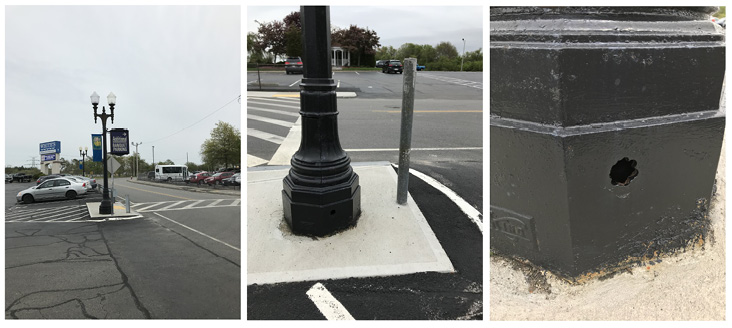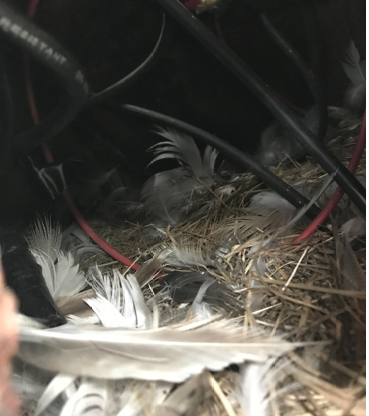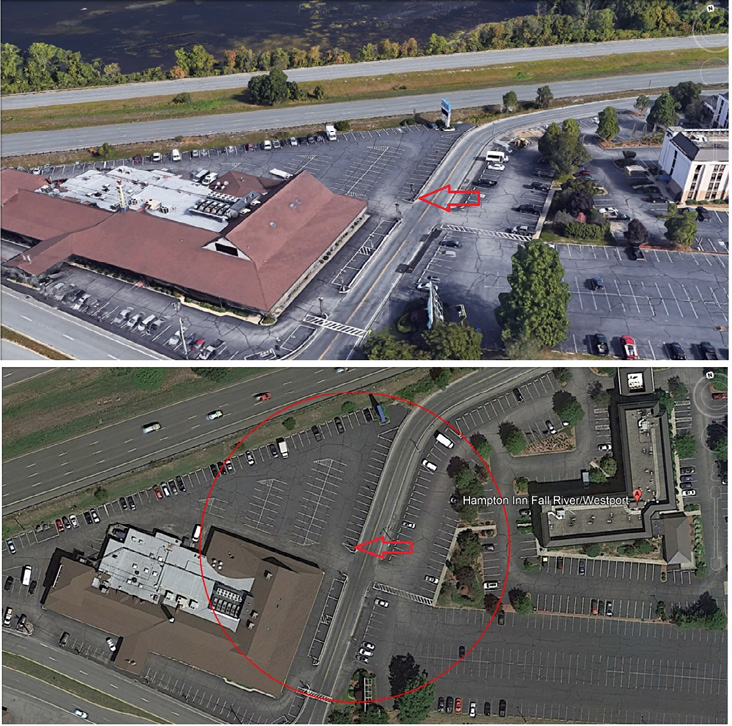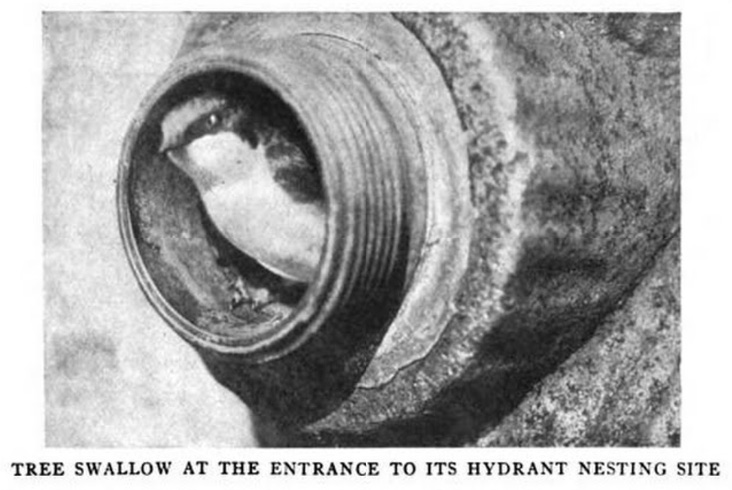Michael C. Allen, Department of Ecology, Evolution, and Natural Resources, Rutgers University, New Brunswick, New Jersey

Fig. 1. The ‘iron snag' in Westport, Massachusetts. Three views of the lamppost that contained a Tree Swallow nest. Left photo: looking northeast, showing the vegetation along the margin of Interstate 195 in the distance. Center photo: looking east, showing the nearest greenery, a hotel courtyard 35 meters away. Right photo: a close-up view of the base of the lamppost showing the drilled cavity entrance. Photographs by the author.
I observed a Tree Swallow (Tachycineta bicolor) nest in Westport, Massachusetts that was unusual in three ways: (1) it was in an iron lamppost; (2) it was surrounded by pavement with no vegetation nearby; and 3) the cavity was near ground level.
The nest cavity entrance was a roughly circular hole 4.0 centimeters tall and 4.1 centimeters wide near the base of an iron lamppost, 15.1 centimeters above the ground (i.e., from the concrete pad to the bottom of the hole; Figure 1). No other posts nearby had a similar hole, which may have been originally drilled to access the electrical wiring. The outer portion of the nest was visible through the opening, and the nest, a mass of fine grasses containing many feathers of a variety of types and sizes, appeared typical of the species (Winkler et al. 2011; Figure 2). The inner cup and contents of the nest were not visible. The nest was apparently built on or very near to the ground (equivalent to the floor of the cavity) within the base of the post, situated among the electrical wires.
The lamppost, with an exact location of latitude: 41.67954 and longitude: -71.11356, was around five meters tall and was one of seven lining the parking lot of White's Regional Hospitality Center along its boundary with Old Bedford Road (Figure 3A). The surroundings were mainly asphalt, concrete, and buildings, with only 10% of the land in a one-hectare (2.5 acre) circle surrounding the nest consisting of vegetation (as measured from aerial photos in Google Earth Pro; Figure 3B). The nearest area of vegetation was a small courtyard at the adjacent Hampton Inn, 35 meters to the east, and the next was the grassy edge of Interstate 195, 46 meters to the north. Watuppa and South Watuppa Pond lie 129 and 113 meters to the north and southwest, respectively.

Fig. 2. A view inside the lamppost cavity nest of a Tree Swallow. The nest was constructed among the wires in the base of an iron lamppost in Westport, Massachusetts. Photograph by the author.
I first witnessed a Tree Swallow exit the hole at the base of the lamppost around 12:50 pm on May 16, 2018. It then joined a second individual, apparently its mate, perched on an electrical wire across the street (visible in Figure 1). After a few minutes, the first bird reentered the hole. I later performed two extended observation sessions to better understand the status of the nest given that its contents were not visible. My observations were as follows, with notes on the presumed sex of the individual as inferred from behavior in parentheses:
Observation session 1: May 16, 2018, 4:19 – 5:07 pm.
4:36. A single Tree Swallow (the male of the pair) arrives nearby, and alternates perching on the wire, preening, and circling around the lamppost while calling. It leaves the area at 4:50.
4:38. A second individual (the female) briefly joins the first and then enters the nest cavity where it remains for the duration of the observation.
Observation session 2: May 17, 2018, 8:11 – 9:55 am (light rain falling).
8:19. One individual (male) circling the parking lot and occasionally very near the lamppost, then leaves the area at 8:32.
8:33. Second individual (female) exits nest, forages in the general area, and then presumably the same individual reenters the nest at 8:38.
9:30. Tree Swallow arrives (male) circles the post, calling, perches on the wire across the street, circles the post calling again and leaves the area at 9:36.
9:40. Tree Swallow (female) exits the nest, forages around the hotel courtyard and then flies out of sight.
9:48. Four Tree Swallows (the nesting pair and a rival pair) appear at the nest post, and engage in an aerial confrontation (at least two chases occur). One individual (the incumbent female) lands at the cavity entrance three times, then enters the nest. Two birds (the rival pair) disperse.
9:49. A second individual (the incumbent male) enters the nest, and then presumably the same bird leaves the nest and the area at 9:50.

Fig. 3. Aerial views of the surroundings of a Tree Swallow nest discovered in a lamppost in Westport, Massachusetts. The arrows point to the nest. A one-hectare circle is superimposed on the bottom photo for scale. The hotel courtyard (the nearest vegetation) is visible in the right side of the circle, and Interstate 195 is at the top. Watuppa Pond is visible in the top of the oblique (top) photo. Aerial images from Google Earth Pro.
The above observations are suggestive of an active nest in the incubation stage. Female Tree Swallows typically do all the incubating, and males frequently perch nearby, occasionally visiting the entrance or briefly entering the cavity (Winkler et al. 2011). The two complete ‘off bouts' I observed were five and eight minutes long, comparable to the published averages of seven to nine minutes (ibid.). The one complete incubation bout I observed was 62 minutes, considerably longer than the published averages of 11 to 15 minutes. This may have been due to the rainy conditions. Nests in the nestling stage are typically visited much more frequently and by both parents (ibid.).
Tree Swallows readily use nest-boxes, but documented nesting in other human infrastructure has been infrequent. Examples in the literature are (1) a disused fire hydrant (Nichols 1920; Figure 4); (2) a steel drum (Dring 1981, cited in Winkler et al. 2011); (3) pipes on an active ferry boat (Common 1942); and (4) cracks in the eaves of roofs (Tyler 1942). Many other cavity nesting species readily or even preferentially nest on human structures, and the fact this behavior is relatively rarely documented in Tree Swallows may reflect a general avoidance. The mechanisms of cultural and genetic adaptation in birds to nesting on human structures are worthy of further study, especially in cavity nesting species, which tend to be nest-site limited (Newton 1994). A North American congener, the Violet-green Swallow (Tachycineta thalassina), is not known to nest on human infrastructure, aside from nest boxes attached to houses (Brown et al. 2011). Comparative studies of related groups of species, for example the eight Tachycineta swallows, or the broader group of 30 or so cavity-nesting "core martins" of the Hirundininae subfamily, (Sheldon et al. 2005), would shed light on these behaviors.

Fig. 4. A Tree Swallow at the entrance to its nest in an abandoned fire hydrant in Long Island, circa 1920. From Nichols (1920).
Tree Swallow nesting habitat is typically open wetland or grassland with dead trees, including beaver swamps and the edges of marshes and old fields. However, a great deal of flexibility has been noted in the surroundings of the nest site as long as open water for foraging is available (Winkler et al. 2011). The surroundings of the lamppost were remarkably barren: 90% of the area within a one-hectare circle (2.5-acres) around the nest is paved. However, its broader location between two large ponds likely adds to its attractiveness. There is little information on the foraging range of this species, but most nesting material is gathered within 30 meters of the nest and birds typically defend a radius of approximately 15 meters from other swallows (ibid.).
The height of natural nest cavities averaged 3.4 meters in Ontario (n = 48; Rendell and Robertson 1989) and 4.6 meters in Oregon (n = 31; Dobkin et al. 1995). While no studies state the minimum nest height, Dr. Wallace Rendell (personal communication) provided me with that number for his sample of 48 nests in Ontario: 0.75 meters. This is roughly the same height as the fire hydrant nest in Long Island, based on the photograph in Nichols (1920). Therefore, the lamppost nest at only 0.15 meters appears to be the lowest Tree Swallow nest documented. Otherwise, the measurements of the lamppost nest, including "tree" height, "tree" diameter, and cavity entrance dimensions, are within normal bounds (Winkler et al. 2011).
I thank Jamie Morgan and Mike Newhouse for inviting me to Westport, Massachusetts, Daisy Morgan Allen for accompanying me in the field, and Wallace Rendell for swiftly replying with his nest height data from the 1980s.
Literature Cited
- Brown, C. R., A. M. Knott, and E. J. Damrose. 2011. Violet-green Swallow (Tachycineta thalassina), version 2.0. in The Birds of North America Online (A. F. Poole, ed.). Ithaca: Cornell Lab of Ornithology.
- Common, M. A. 1942. International Swallows. Auk 59: 437.
- Dobkin, D. S., A. C. Rich, J. A. Pretare, & W. H. Pyle. 1995. Nest-site Relationships Among Cavity-nesting Birds of Riparian and Snowpocket Aspen Woodlands in the Northwestern Great Basin. Condor 97 (3): 694-707.
- Dring, P. 1981. Some Unusual Tree Swallow, Iridoprocne bicolor, Nest Records. Inland Bird-Banding 53 (2): 25-26.
- Newton, I. 1994. The Role of Nest Sites in Limiting the Numbers of Hole-nesting Birds: A Review. Biological Conservation 70 (3): 265-276.
- Nichols, J. T. 1920. The Tree Swallow on Long Island. Bird-Lore 22: 279-281.
- Rendell, W. B., & R. J. Robertson. 1989. Nest-site Characteristics, Reproductive Success and Cavity Availability for Tree Swallows Breeding in Natural Cavities. Condor 91 (4): 875-885.
- Sheldon, F. H., L. A. Whittingham, R. G. Moyle, B. Slikas, and D. W. Winkler. 2005. Phylogeny of Swallows (Aves: Hirundinidae) Estimated from Nuclear and Mitochondrial DNA Sequences. Molecular Phylogenetics and Evolution 35 (1): 254–270.
- Tyler, W. M. 1942. "Iridoprocne bicolor (Vieillet) Tree Swallow" in Life Histories of North American Flycatchers, Larks, Swallows, and Their Allies (A. C. Bent, ed.). Bulletin of the United States National Museum 179, 384-400. Washington : United States Government Printing Office.
- Winkler, D. W., K. K. Hallinger, D. R. Ardia, R. J. Robertson, B. J. Stutchbury, and R. R. Cohen. 2011. Tree Swallow (Tachycineta bicolor), version 2.0. in The Birds of North America Online (A. F. Poole, ed.). Ithaca: Cornell Lab of Ornithology.
